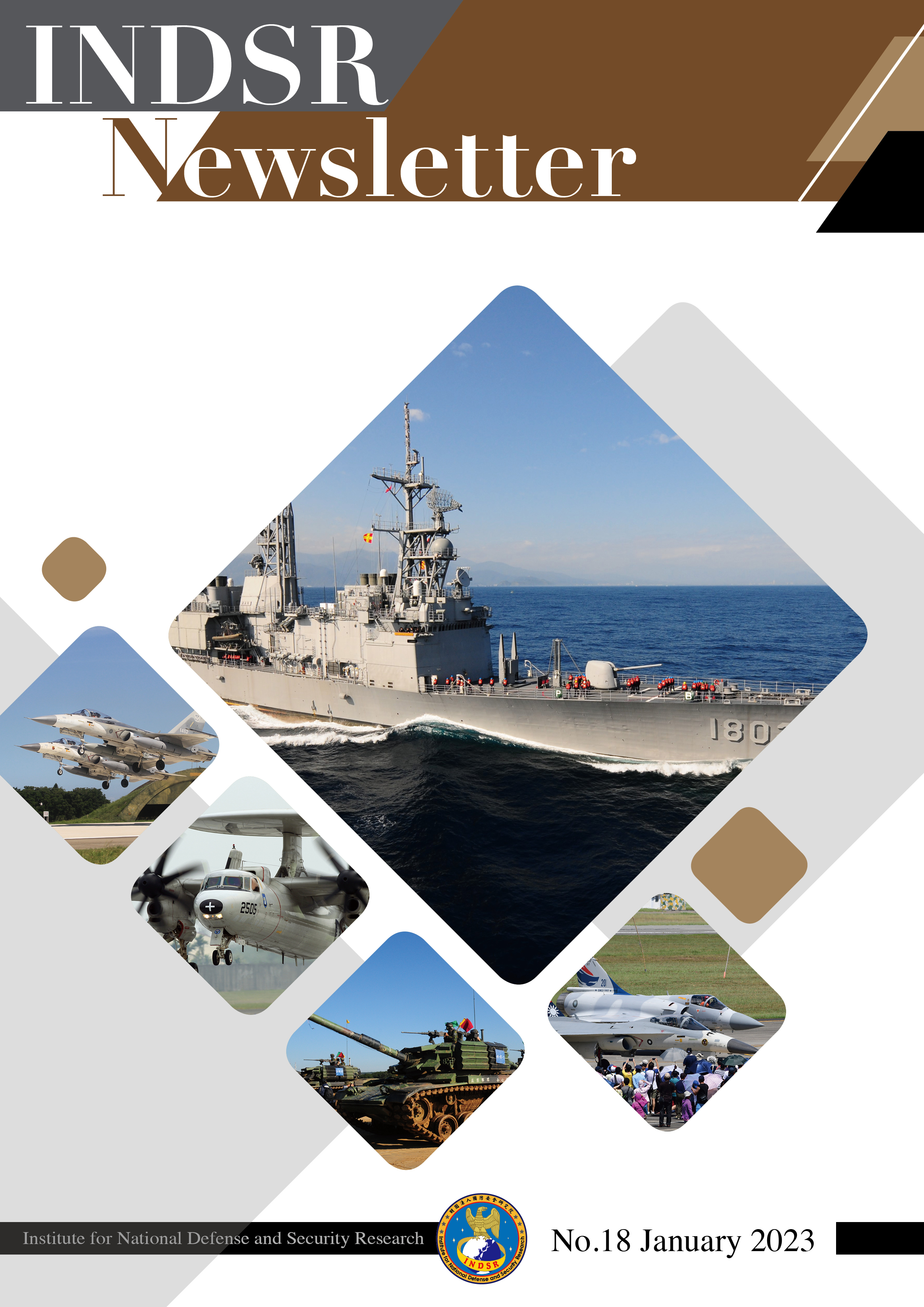The Strategic Implications of the USAF Development of the B-21 Bomber
2023.04.17
Views
417
PDF link:
1.News Highlights
The US Air Force B-21 bomber, developed by Northrop Grumman, was launched on December 2, 2022, at Air Force Plant 42 in Palmdale, California. In tribute to the air raid on Tokyo led by Jimmy Doolittle, the World War II US Army Air Force hero, on April 18, 1942, the US Air Force invited Lt. Col. Richard Cole, co-pilot of Doolittle’s B-25 bomber, to reveal the name of the new bomber, “Raider,” at the Air Force Association’s annual meeting in 2016 with a B-25 bomber displayed in the ceremony. [1] The rollout of the B-21 also symbolizes a milestone in the US Air Force’s reshaping of the bomber force.
2. Security Implications
2-1. Speculating the performance and mission from B-21’s appearance
Due to the extreme secrecy of the US Air Force, although the B-21 was officially unveiled, only front-view photos were provided. Still, it’s apparent that the aircraft has very good “Low Observation” (LO, or stealth) characteristics. Observing from the front, although the B-21 adopts a full-wing design similar to the earlier B-2 bomber, its seemingly smaller profile may have the weapon payload sacrificed. Its main landing gear is designed with two wheels, unlike the larger and heavier B-2 that employed four tandem main wheels. The front wheelhouse door opens from the side and does not have jagged edges like the B-2.
The small front windshield panels offer adequate upward and forward views, which ensures visual observation of the in-flight refueling procedures; however, the visibility in all other directions is poor. The small, curved side windows are probably a compromise for low visibility and minimization of radar reflection. In fact, there were window-less versions during B-21’s design process, and the B-2, developed in the 1980s, was also given serious consideration to eliminating the windows for the best low-visibility profile.
Unlike other US Air Force bombers, the B-21 has a light-gray appearance that means a wider range of mission availability and is not limited to a specific type of attack. The lighter shade means the B-21 may also be suitable for daylight operations. This also manifests that the era that stealth bombers are limited to nighttime operations is coming to an end, but the fuselage color may still change before the design of the B-21 is finalized.
2-2. The B-21 employs the best stealth design
With a wide, flat frontal profile, the B-21 has excellent low observability characteristics as the shapes of its entire fuselage blend smoothly to minimize feature variations and the overall height. To stealth aircraft, the design of the intake ducts always poses a challenge. The B-21’s intakes are seamlessly integrated into the upper surface of the fuselage to minimize cross-section visibility; the elimination of support struts and airflow separators in the intake also suggests that this is a twin-engine aircraft. Taking advantage of the latest material, structures, and designs, it’s now possible to build and assemble large composite material components to reduce the number of airframe parts and, therefore, the seams on the exterior, which significantly lowers the radar observability, the high costs for maintaining stealthiness, and the amount of time spent on the ramp for maintenance. This is made possible by the “Digital Twin” technology currently popular in the US aerospace industry, which significantly reduces design time and lowers the cost of building and then revising prototypes in the past.
Due to the very limited publicized information, the overall appearance of the B-21, including the outline of the aircraft, the appearance details such as the most sensitive nozzle design, and the avionics systems, such as the radar and sensors, are not yet widely known. Its performance parameters, including speed, range, maximum altitude, and payload capability, are still classified as well.
B-21’s future missions will focus on long-range strikes
Obviously, the B-21 will be an extremely efficient aircraft. Its large internal fuel tanks allow long-range flights with fewer in-flight refuelings, and the large weapon bay can carry a considerable amount of munitions in stealth mode. It’s estimated to have at least half B-2’s capacity or be able to carry a Massive Ordnance Penetrator (MOP) like the GBU-57/B. According to the report, the “keel” of the B-21 is deeper and wider than that of the B-2, suggesting that it may feature a large weapon bay and more fuel capacity for future long-range missions that require direct flights from the continental US to the conflict zones. The width of the B-21 is only about 20 feet shorter than the B-2, but B-21 has a greater swept angle, and the actual wing shape is still unknown.[2]
As part of the US Air Force’s long-range strike infrastructure, most details of B-21 are still classified, and it may be equipped with some new weapon systems. It is designed to carry long-range stand-off weapons, such as the B61-12 nuclear bomb and cruise missiles with conventional warheads. In addition, the B-21 is also a versatile platform with NTISR (Non-traditional Intelligence, Surveillance, and Reconnaissance) and data-sharing capabilities to handle missions from intelligence acquisition to combat theater management.[3]
3. Trend Observation
According to Defense News, as the war between Russia and Ukraine has yet to end, and China’s continued psychological and military threats against Taiwan have caused international concern, the unveiling of the B-21 by the US is an apparent stern warning to its potential competitors. The B-21 is designed for future operations in environments with extreme threats to ensure the continued effectiveness of US air power. Defense News believes that if a war breaks out between the US and China, the US Air Force needs bombers capable of infiltrating enemy airspace without being detected, and B-21’s excellent stealthiness gives it the ability to perform such penetrating strikes.
3-1. US Air Force to simplify its bomber fleet to reduce costs
The B-21 is scheduled to have its maiden flight in 2023 and will gradually replace the B-1 and B-2. Since the B-1 and B-2 fleets are in small numbers, they are too costly to operate, support, upgrade, and perform life extension works. The B-1B bomber is currently tasked with cruise missiles for ultra-long-range ground attacks and anti-shipping missions; these missions include 40 hours of non-landing flights launched from the continental US. Since the aging B-1 fleet is soon to be retired and replaced by the B-21, US Air Force expects to deploy B-21 in the mid-2020s while gradually phasing out B-1 until the last in 2036.
Due to the high maintenance and operating cost, the B-1 and B-2 have been on the retirement list for a long time. Following the introduction of B-21, the retirement of B-1 and B-2 will effectively reduce overall operating costs and strengthen the strike capability of the US bomber fleet. With the expandability reserved by the early airframe design, the B-52H, another strategic bomber in service with the US Air Force since 1961, has undergone several structural and performance enhancements. Compared with other models, the maintenance cost of the B-52H is relatively lower than other aircraft; and it is capable of carrying a wide range of munitions such as JDAM (Joint Direct Attack Munition) and larger weapons, including hypersonic missiles. The US Air Force plans to replace B-52’s current engines with eight Rolls-Royce F130 for improved fuel efficiency and increased service life. The upgraded B-52 will serve in parallel with the B-21 of the next generation to meet the challenges of complex combat environments.
3-2. Standoff deployment of US bombers counters the opponents
The B-1 bombers of the US Air Force’s 28th Wing are currently training for ultra-long-range strike missions for the crews to experience the so-called “CONUS-to-CONUS” flights, which start from the Ellsworth Base and end in the same base after non-landing flights. In addition to long flights, the crews are also training for nighttime in-flight refueling and other tasks.
In 2018, the B-1 was certified to carry AGM-158C LRASM (Long Range Anti-Ship Missile), a variation of AGM-158 JASSM (Joint Air-to-Surface Standoff Missile). In 2020, the US Air Force released photos of loading AGM-158 on B-1 in Guam to demonstrate its airborne anti-ship capabilities in the Indo-Pacific region. The bombers can be rapidly deployed to the edge of the western Pacific Ocean to carry out sea suppression missions and to engage maneuvering sea targets round the clock. Should any conflict occur in the Taiwan Strait or the South China Sea, the US bombers, even if they were from the continental US, can reach the contested area within a dozen hours to quickly respond and suppress hostile vessels. Bombers launched from Guam take only 10 hours to reach the South China Sea. Yet, navy vessels would need a few days to arrive in the same target area, which can be very difficult to keep up with the pace of modern warfare and effectively respond to situation changes.
Although the Russian Navy has the geographical advantage in the Black Sea, it still needs access to the Turkish-controlled Dardanelles and Bosphorus Straits to enter and leave the Black Sea. According to the Montreal Convention, vessels from countries that do not have a Black Sea shoreline are not allowed to stay in the Black Sea for more than 21 days, and warships over a certain tonnage are not allowed to enter or leave either. To the US, bombers can circumvent such restrictions and carry out strike missions against the targets in the Black Sea and even the surrounding areas, such as the Middle East. In May 2020, the US Air Force sent two B-1Bs on long-range, non-landing flights to the Black Sea and participated in joint exercises with Ukrainian and other air forces to practice striking targets in Russia and intercepting Russian ballistic missiles. A B-1 can carry up to 24 AGM-158C anti-vessel missiles and launch them in safe airspace far away from enemy air defense missiles to suppress the enemy surface ships. That means it takes only two B-1s to effectively suppress the current establishment of Russia’s Black Sea fleet of about 50 ships of different sizes. [4]
3-3. Agile Combat Employment of bombers counters the opponents
In recent years, the US Air Force has emphasized the Agile Combat Employment (ACE) concept that deploys bombers to contested areas through long-range flights to verify the Dynamic Force Employment capabilities for its “strategically predictable but tactically unpredictable” goal. As adversaries continue to improve their Anti-Access/Area Denial (A2/AD) capabilities, large frontline US bases could be attacked by the enemy and lose their ability to support the war effort. The long-range bombers provide tremendous flexibility and will continue to acquire the capability of delivering new weapons, including hypersonic missiles, in the coming years to enhance their long-range strike capability further. In the future, the bombers will play an important role in sea suppression missions to share the burden on the navy and increase the arsenal options available to the US military in the Indo-Pacific region. This makes it more difficult for adversaries, especially Russia and China, to predict the military deployment and maneuvering of the US forces that could pose threats to them.
(Originally published in the 70th “National Defense and Security Biweekly”, December 30, 2022, by the Institute for National Defense and Security Research.)
(The contents and views in the assessments are the personal opinions of the author, and do not represent the position of the Institute for National Defense and Security Research.)
[1] Stephen Losey, “‘Deterrence the American Way’: The New B-21 Bomber Debuts,” Defense News, December 3, 2022, https://www.defensenews.com/air/2022/12/03/deterrence-the-american-way-the-new-b-21-bomber-debuts/?utm_source=Sailthru=email=dfn-breaking.
[2] John Terpak, “Eight Features That Show the New Raider is Not the B-2.1,” Air Space Forces Magazine, December 5, 2022, https://www.airandspaceforces.com/eight-features-that-show-the-new-b-21-raider-is-not-the-b-2-1/?fbclid=IwAR068LPa5E55T9vUiLegdM4OSxyLQTHXmTWFTdbHARmHdRPPWQLsGRUVtZQ.
[3] Joseph Trevithik, “B-1B Bomber’s New Ultra Long-Range Focus Hints at Future B-21 Ops,” The Drive, December 14, 2022, https://www.thedrive.com/the-war-zone/b-1b-bombers-new-ultra-long-range-focus-hints-at-future-b-21-ops.
[4] Joseph Trevithik, “Air Force Reveals B-1Bs Were Practicing Decapitating Russia’s Black Sea Fleet Last Week,” The Drive, June 9, 2020, https://www.thedrive.com/the-war-zone/33787/air-force-reveals-b-1bs-were-practicing-decapitating-russias-black-sea-fleet-last-week.


